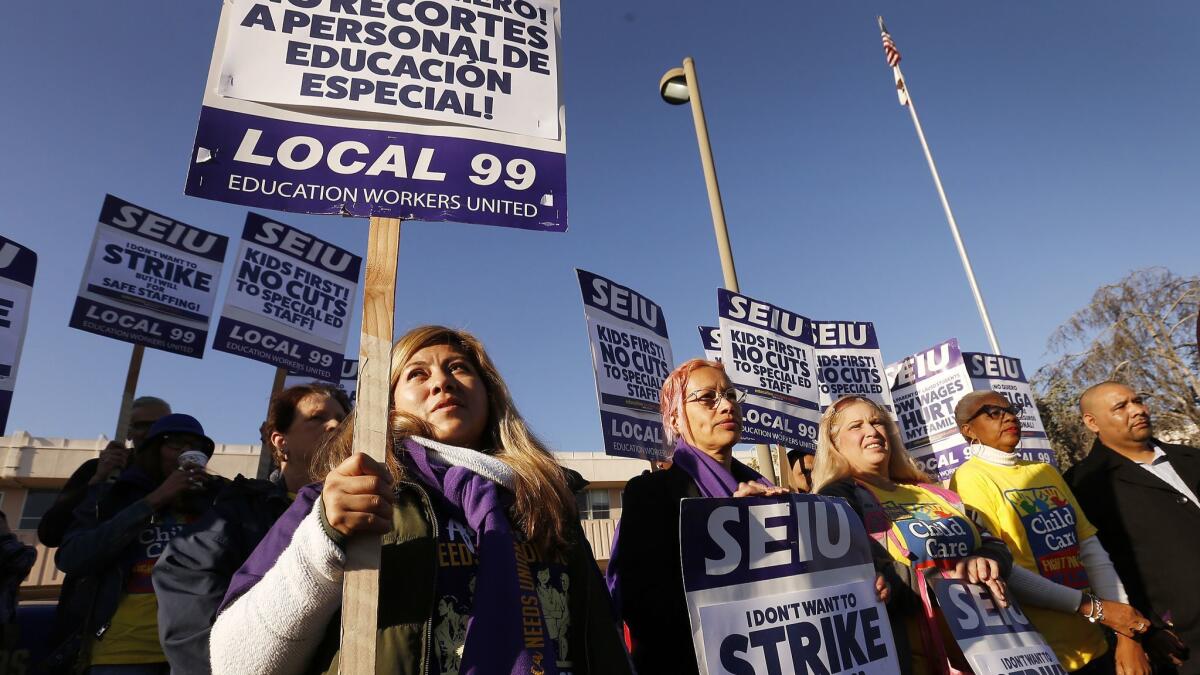Q&A: One deal done, labor challenges remain for L.A. Unified

- Share via
It’s been a busy week for L.A. school unions.
First a union of nonteaching L.A. school workers announced they’d strike for a day on May 15. Then the teachers union said it would lend its support, urging its members not to cross the picket lines. Hours later, L.A. Unified on Tuesday reached a tentative contract deal with the workers’ union, heading off the work stoppage.
That’s fortunate because the action was awkwardly scheduled for the first official work day for new Supt. Austin Beutner.
The deal is with Local 99 of the Service Employees International Union, which represents about 30,000 full- and part-time workers, including bus drivers, teacher assistants, campus aides, cafeteria workers and custodial staff. The agreement — which still must be approved by members — includes wage increases of 3% to 4%, retroactive to July 1, 2017, when the previous contract expired. A second round of pay boosts would kick in next year.
Other unions, including United Teachers Los Angeles, still are in negotiations. They may now be under increased pressure to settle on similar terms.
Questions remain about how many increases the district can afford, given that district officials say a grave financial crisis is looming.
Can the district afford this contract?
The district estimates that its costs would increase at least $100 million (in a $7-billion budget) over the three years of this pact.
But Local 99 made two concessions that at least could control some district costs. Only the initial raises — of 3% to 4% — are ongoing. Later increases — also of 3% to 4% — initially will be one-year bonuses. They’ll become permanent only if L.A. Unified certifies next year that it has enough funding to pay its bills through June 2020.
The union also agreed to make it harder for future employees to earn lifetime health benefits. To qualify from now on, their age at retirement added to their years of service must equal at least 87, and they will have to have worked for the district for 30 consecutive years.
How well has the district balanced the importance of helping these union workers with other school district priorities?
Local 99 includes some of the lowest-paid employees in the school system, and three years ago the district took a high-profile stand in the broader national campaign to get all workers to at least $15 an hour. The district also has taken stands to give full health benefits — and the chance to earn lifetime health benefits — to part-time workers and their family members.
Such actions have won praise, especially because many Local 99 members are district parents. But critics have wondered aloud whether the district could afford these higher pay scales and benefit packages, which many other school systems do not provide.
Is Local 99 a powerful player in district politics?
The union, which has a lower public profile than UTLA, almost always supports incumbent school board members — and they try to reward that loyalty. Local 99 straddles the barrier that divides most school board candidates — who typically must choose between financial backing from the teachers union or supporters of charter schools. Most charters are nonunion and have fewer people working in the sorts of jobs union members have. But Local 99 members have children in both traditional and charter schools.
Why are some Local 99 workers getting larger percentage raises than others?
Some higher-salaried nonteaching employees are getting a larger percentage raise. This is to make up for the prior contract, when their increase in terms of percentage was lower than that of their colleagues who made less than them. In that earlier contract, the district agreed to bring all workers up to at least $15 an hour over three years. That meant that some workers at the low end got bigger increases. The new contract addresses that discrepancy.
What else is in the contract?
The district spends a lot on privately employed aides to help disabled students. L.A. Unified will try to train district aides to do the work at lower cost, but will raise their pay in exchange for mastering the necessary skills.
The district will put $2 million into a “cleanliness fund” to keep schools in better condition and $400,000 into a training and education fund — because many Local 99 members start as low-skilled workers. The union and district together will decide how best to spend this money.
Sign up for Essential California
The most important California stories and recommendations in your inbox every morning.
You may occasionally receive promotional content from the Los Angeles Times.







